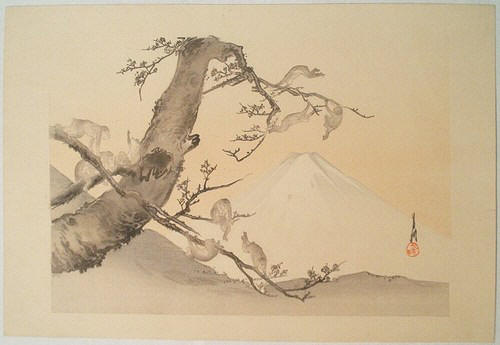
- This event has passed.
Call for Papers: International Workshop – Seasonal Imagery in Japanese Language, Culture and Literature
Seasonal imagery is omnipresent in many aspects of Japanese life and culture. Hanami and momijigari have become central elements in Japanese soft culture and attract numerous viewers both from Japan and abroad. The sensitivity to the fleeting nature of seasons and by association of life, is an important part of Shintō and Buddhism. The focus on the cycles of the Earth and on the agrarian calendar has been manifested in the seasonal festivals and activities. Japanese architecture also reflects this closeness to nature. The shinden structure that emerged in the Heian period created a closeness to nature and the changing seasons.
The ubiquity of seasonal imagery in Japanese language, culture and literature is not a recent phenomenon. The earliest known anthology of Japanese poetry, Kokinshū (10th century) abounds with elements of the natural world. Waka and other forms of pre-modern poetry use nature as one of their primary themes and inspired modern Japanese literature and visual culture. From The Tale of Genji, for example, in which most female characters are named after a natural object or phenomena which is associated with a specific season (Shirane, 2012) to the many examples of the seasonal trope in Japanese manga.
This workshop will take place during the celebrations of Japan’s Culture Day and will coincide with the 50th anniversary of Kawabata’s death. To commemorate his passing, we especially welcome papers considering how the seasons play a central role in Kawabata’s novels in understanding the Japanese spirit and worldview.
Event date: 5.11.2022
FULL PROGRAMME
Seasonal imagery in Japanese language, culture and literature
Saturday 5th November
Organised by Mutual Images Research Association
and
The Sembazuru Centre for Japanese Studies [SCJS]
8h30
Welcome and opening speeches
Aurore Yamagata-Montoya, PhD, Chair of Mutual Images Research Association (France)
Hiroshi Ueda, Extraordinary and Plenipotentiary Ambassador (Japanese Embassy in Romania)
Rodica Frentiu, Prof. PhD habil., Chair of the Department of Asian Languages and Literatures (Babes-Bolyai University, Romania)
9h15 – 10h15
Guest speaker
How the ‘Coming of Spring’ is Differently Encoded Linguistically across Languages: An Interim Report
Yoshihiko Ikegami, Professor Emeritus (Tokyo University, Japan)
10h30-12h30
Panel 1- The seasons in visual and performance arts
Moderator: Ciliana Tudorică
A Farewell to the Past: Employing the Idealization of the Seasons as a Means to Overcome the Fear of the Future in Takarazuka Revue’s Musical Performance Sekkashô (flower troupe, 2016)
Maria Gradjian, Hiroshima University (Japan)
Dressed by Nature, Adorned by Design: Seeing, fFeling, Marking the Seasons with Kimono
Lucile Druet, Kansai Gaidai University (Japan)
Seasonal Elements in Toru Takemitsu’s Film Music
Xie Mohan, Xiamen University (China)
Seasonal Imagery in (Global) Ikebana Practice Today: Opportunities and Challenges
Marlies Holvoet, Ghent University (Belgium)
13h-14h30
Panel 2- The seasons in Japanese Literature
Moderator : Ciliana Tudorica
The Seasons of War: The Traditional-Style War Haiku of Hasegawa Sosei
Lenin Emmmanuel Gutierrez, Nagoya University (Japan)
Love and Death Through the Prism of Seasons: The Word “Pampas Grass” in the Collected Poems of Lady Ise
Maria Elena Raffi, IFRAE (France)
Subversive Imagology: An Eco-Critical Analysis of Ibuse Masuji’s Kakitsubata (1951) and Taguchi Randy’s Zōn ni te (2013)
Veronica de Pieri, University of Bologna (Italy)
15h15-16h45
Panel 3- Perception of the Japanese seasons in popular culture
Moderator : Ioana Tosu
Sakura: Representations of the Cherry Tree in Fiction and its Relationship with Japanese Culture
Aline Silva Dejosi Nery, Federal University of Rio de Janeiro (Brazil)
and Lucas Mascarenhas de Miranda, Federal University of Juiz de Fora (Brazil)
Four Seasons in Japan: Marketing Seasonal Pre-Wedding Photography for Foreign Couples
Aurore Yamagata-Montoya, Mutual Images Research Association (France)
Cherry Blossoms and Sweet Sentimentalism: Analysis of the sakura Song Boom in the 2000s
Teppei Fukuda, University of Oregon (USA)
16h45-17h15
Panel 4- Commemorating Kawabata Yasunari
Moderator : Oana Bîrlea
A Living Space Under the Sign of the Rythms of Nature: Kyoto in The Old Capital by Kawabata Yasunari
Sabina Maria Sava, independent scholar (Romania)
Rereading Yasunari Kawabata: The Winter Imaginary in the Novel Snow Country (Yuki guni, 1935-1937/ 1948
Rodica Frentiu and Florina Ilis, Babes-Bolyai University (Romania)
17h15-17h30
Closing comments
***
Online workshop
*Workshop language: English
*Participation details: free event for all participants.
Preregistration required for non-presenters.
Paper presentations may include, but are not limited to the following topics:
-Symbolism of the seasons;
-Transience of nature and passing of seasons;
-Hanami, tsukimi and momijigari;
-Seasons and Japanese language: kigo, saijiki…;
-Seasons in pre-modern Japanese literature: kanshi, waka, renga, haikai;
-Seasons and haiku;
-Seasons in Japanese modern and contemporary literature: fiction and non-fiction;
-Seasons in Kawabata’s novels;
-Pictural representations of the seasons;
-Seasons in Japanese architecture;
-Seasons and religion: evanescence, annual observances and religious rituals, …;
-Seasons in Japanese mythology and religion;
-Seasons in popular culture;
-Japanese seasonals celebration in Western culture and literature;
-Seasons and tourism in Japan.
We encourage submissions with an interdisciplinary and multidisciplinary approach.
This conference is open to both postgraduates and academics at any stage of their career.
In addition to individual submissions, we welcome the submission of pre-formed panel proposals. Please send an abstract for each paper, as well as the title of your panel proposal.
DEADLINE: 300 words abstracts should be submitted by 15th September 2022. Please note that the presentations should be of around 20 minutes, followed by a 10 min Q&A session.
Abstracts should be submitted to the following address: mutualimages@gmail.com
This conference is organized in collaboration between The Sembazuru Japanese Centre for Japanese Studies (Faculty of Letters, Babes-Bolyai University, Romania) and Mutual Images Research Association (MIRA). More information on www.mutualimages.org
WRITING RECOMMENDATIONS
Abstracts should be sent in Word format with the following information and in this order:
- a) title of abstract, b) body of abstract, c) up to 6 key words, d) author(s), e) affiliation, f) email address.
Please use plain text (Garamond 11) and abstain from using footnotes and any special formatting, characters or emphasis (such as bold, italics or underline).
E-mails should be entitled: “MUTUAL IMAGES 2022”.
All abstracts will be anonymously reviewed. Authors will be notified via email on the results of the review by 10th October 2022.
We acknowledge receipt and answer to all paper proposals submitted. If you do not receive a reply from us in a week you should assume we did not receive your proposal. We suggest, then, to resend it.
Papers might be considered for publication in the peer-reviewed open access Mutual Images Journal.
Joint Organising Chairs:
Prof. Dr. Habil. Rodica Frentiu, The Sembazuru Japanese Centre for Japanese Studies, Babeş-Bolyai University, Romania
Lect. Dr. Florina Ilis, The Sembazuru Japanese Centre for Japanese Studies, Babeş-Bolyai University, Romania
Lect. Dr. Oana Birlea, The Sembazuru Japanese Centre for Japanese Studies, Babeş-Bolyai University, Romania
Dr. Ciliana Tudorica, The Sembazuru Japanese Centre for Japanese Studies, Babeş-Bolyai University, Romania
PhD Ioana Tosu, The Sembazuru Japanese Centre for Japanese Studies, Babeş-Bolyai University, Romania
Dr. Aurore Yamagata-Montoya, Mutual Images Research Association, France
Dr. Maxime Danesin, Mutual Images Research Association, France
For further details of the conference, please visit: http://mutualimages.org
For any further information, you can contact us at: mutualimages@gmail.com
Detalii
- Data:
- 05-11-2022
- Ora:
-
08:30 - 17:30
- Categorii:
- Arte și științe umaniste, Centre Culturale, Evenimente Culturale, HOMEPAGE, Școli Academice, SIDEBAR
- Site web:
- https://mutualimages.org/
Organizator
- Centrul de studii japoneze Sembazuru
- Mutual Images Research Association, France
Locatie
- Online


